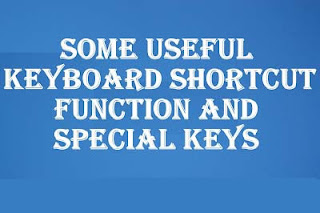 Keyboard shortcuts are combination of two or more keys that you can use to perform a task that would typically require a mouse or other pointing device. Keyboard shortcuts can make it easier to work with your PC, saving you time and effort as yo
Keyboard shortcuts are combination of two or more keys that you can use to perform a task that would typically require a mouse or other pointing device. Keyboard shortcuts can make it easier to work with your PC, saving you time and effort as you work with Windows and other apps.
Some Shortcut and Special keys.
Function keys
F1 – Display help.
F2 – Rename the selected item.
F3 – Search for a file or folder.
F4 – Display the address bar list in file explorer.
F5 – Refresh the active windows.
F6 – Cycle through screen elements in a window or on the desktop.
F10 – Activate the menu bar in the active app.
Special keys
Alt+F4 – Close the active item, or exit the active apps.
Alt+Esc – Cycle through items in the order in which they were opened.
Alt+Underlined letter – Perform the command for that letter.
Alt+Enter – Display properties for the selected items.
Alt+Spacebar – Open the shortcut menu for the active window.
Alt+left arrow – Back.
Alt+ Right arrow – Forward.
Alt+Page up – Move up one screen.
Alt+Page Down – Move down one screen.
Alt+Tab – Switch between open apps (except desktop apps).
Ctrl+F4 – close the active document (in apps that allow you to have multiple documents open simultaneously).
Ctrl+A – Select all items in a document or windows.
Ctrl+C (or Ctrl+Insert) – Copy the selected item.
Ctrl+D (or Delete) – delete the selected items and move it to the Recycle bin.
Ctrl+R (or F5) – Refresh the active window.
Ctrl+V (or Shift+Inserte) – paste in the selected item.
Ctrl+X - Cut the selected items.
Ctrl+Y – Redo an action.
Ctrl+Z – Undo an action.
Ctrl+plus (+) or Ctrl+minus (-) – zoom in or out of a large number of items, like apps pinned to the Start screen.
Ctrl+mouse scroll wheel – Change the size of Desktop icons or Zoom in or out of a large number of items, like apps pinned to the start screen.
Ctrl+Right arrow – move the cursor to the beginning of the next word.
Ctrl+Left arrow – Move the cursor to the beginning of the previous word.
Ctrl+Down arrow – Move the cursor to the beginning of next paragraph.
Ctrl+Up arrow – Move the cursor to the beginning of the previous paragraph.
Ctrl+Alt+Tab – Use the Arrow keys to switch between all open apps.
Ctrl+Arrow key (to move to an item) +Spacebar – select multiple individual items in a window or on the desktop.
Ctrl+shift with an arrow key – Select a block of text.
Ctrl+Esc – Open the start screen.
Ctrl+Shift+Esc – Open the task manager.
Ctrl+Shift – Switch the keyboard layout when multiple keyboard layouts are available.
Ctrl+Spacebar – Turn the Chinese input method editor (IME) on or off.
Shift+F10 – display the shortcut menu for the selected item.
Shift with any arrow key – select more than one item in a windows or on the desktop, or select text within a document.
Shift+Detele – Delete the selected items without moving it to the Recycle Bin first.
Right arrow –w Open the next menu to the right, or open a Submenu.
Left arrow – Open the next menu to the left, or close a Submenu.
Esc – Stop or leave the current task.
Notes
The Microsoft Office Word 2007 shortcut key with Keyboard, these keys shortcut mostly works with US keyboard layout any others key layouts some time not work exactly.
The keyboard shortcut you want to use not press + sign between two and three keys. For example – CTRL + Spacebar, you can press only ctrl key then spacebar key not use any press + keys.





